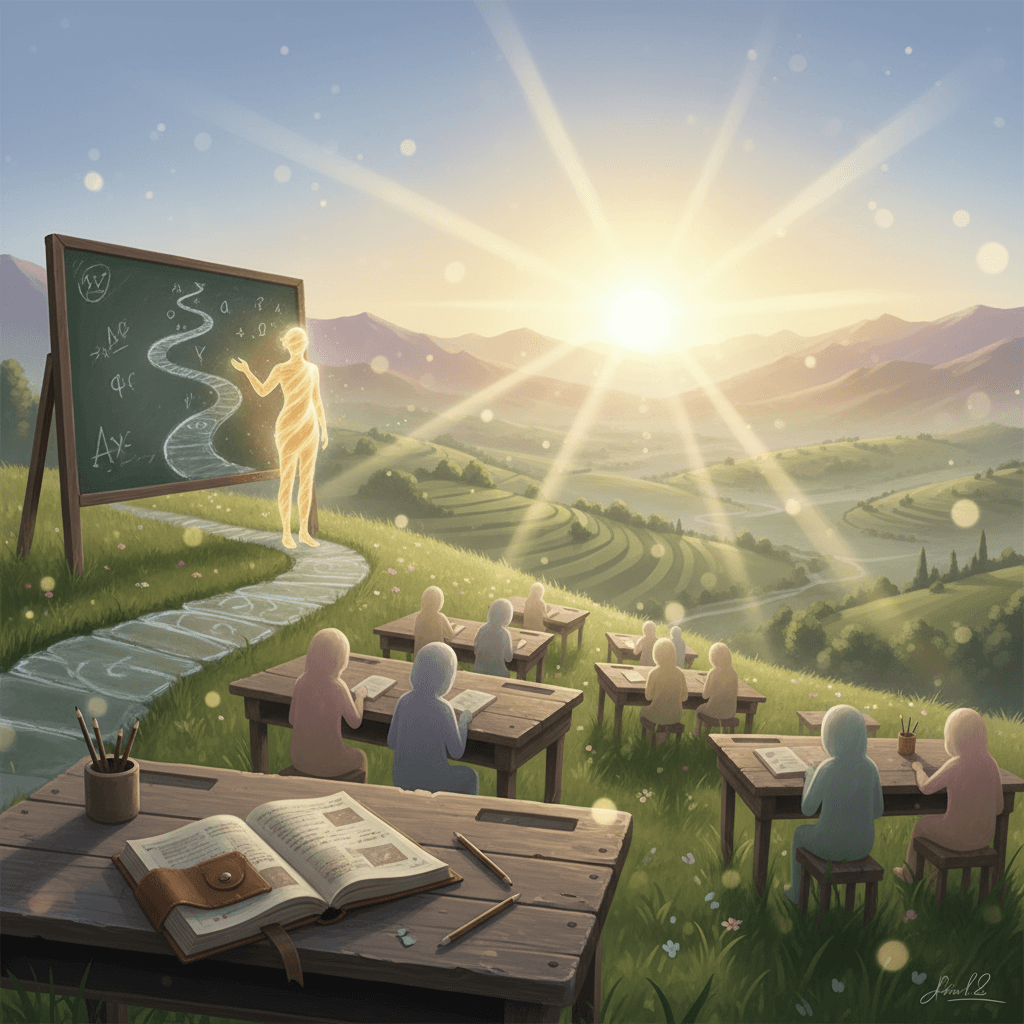When Doubt Learns and Hope Teaches Us
Created at: October 10, 2025

Teach your doubts to be students and your hopes to be teachers — Malala Yousafzai
The Pedagogy in Malala’s Metaphor
Malala Yousafzai’s line invites us to treat our inner life like a school: doubts are novice learners, hopes seasoned instructors. Rather than silencing uncertainty, we enroll it—posing questions, gathering evidence, and refining claims. Meanwhile, hope designs the syllabus, curating values and long-term aims so that inquiry does not wander without direction. In this framing, progress emerges from dialogue within the self. Doubt’s curiosity sharpens our thinking; hope’s guidance protects purpose from fatigue. With this classroom established, we can now ask how, exactly, to help doubt learn and hope teach with rigor.
Training Doubt Through Inquiry
For doubt to be a good student, it needs structure. Plato’s Meno (c. 380 BC) shows how aporia—productive puzzlement—propels learning when guided by disciplined questioning. Likewise, Descartes’ Meditations (1641) uses methodic doubt to rebuild knowledge on firmer ground, demonstrating that skepticism can be constructive rather than corrosive. Modern science institutionalizes this stance: hypotheses are taught by experiments and graded by failure, as Karl Popper’s falsificationism (1959) underscores. Consequently, doubt matures when we give it mentors—clear methods, reliable data, and peer critique—so that uncertainty becomes a lesson plan instead of a dead end. Yet instruction still needs direction; that is hope’s role.
Letting Hope Instruct Purpose
Hope teaches by setting horizons and modeling agency. After surviving an attack in 2012, Malala chose advocacy over withdrawal; her UN Youth Takeover speech (12 July 2013) proclaimed, "One child, one teacher, one book, and one pen can change the world." Here, hope operates as curriculum—offering goals, narratives, and exemplars that make effort feel meaningful. Moreover, hope is not mere cheerfulness; it is a pedagogy of possibilities. By sketching attainable futures, it tells doubt what questions to ask and why the answers matter. In this sense, purpose converts scattered inquiry into progress.
Psychology Behind Hopeful Learning
Research clarifies these roles. Carol Dweck’s Mindset (2006) shows that a growth mindset turns setbacks into instruction, effectively tutoring doubt in resilience. Martin Seligman’s Learned Optimism (1991) links hopeful explanatory styles to persistence and health, while C. R. Snyder’s hope theory (2002) distinguishes agency (will) and pathways (ways), mapping how hope teaches strategy. Neuroscience complements this: dopamine-driven prediction-error signals help brains update plans when reality disagrees with expectations (Wolfram Schultz, 1997). Together, these findings suggest that well-guided doubt updates beliefs, and well-formed hope sustains effort—an evidence-based duet. Next comes practice.
Practices to Mentor Doubt and Hope
Turn doubt into a student by keeping a question log, running small tests, and holding premortems—Gary Klein’s “Performing a Project Premortem” (2007) anticipates failure points so learning arrives early. Conduct brief after-action reviews to capture lessons before they fade. Let hope teach with concrete plans: use implementation intentions—“If X, then I will Y” (Peter Gollwitzer, 1999)—and WOOP (Wish, Outcome, Obstacle, Plan) to marry aspiration with realism (Gabriele Oettingen, 2014). As these habits compound, doubt gains discipline and hope gains credibility, creating momentum. Still, such momentum needs guardrails.
Guarding Against Naive Positivity
Hope untethered becomes wishful thinking; doubt untrained slides into cynicism. Paulo Freire’s Pedagogy of Hope (1992) argues that hope must be critical—anchored in reality, dialog, and action. Similarly, warnings about toxic positivity remind us that suppressing hard feelings short-circuits learning. Therefore, pair every hopeful claim with a test and every skeptical objection with a constructive next step. Doubt prevents indoctrination; hope prevents paralysis. This balance not only strengthens individuals but also equips communities to learn together.
From Inner Classroom to Shared Change
When scaled, this pedagogy shapes movements. Highlander Folk School’s workshops prepared civil rights organizers to interrogate unjust laws while keeping moral hope vivid; Dr. King’s “Letter from Birmingham Jail” (1963) teaches urgency joined to disciplined nonviolence. Likewise, the Malala Fund channels hope into policies and scholarships, transforming vision into infrastructure. In collaborative settings—citizen assemblies, study circles, labs—doubts become collective questions, and hopes set shared milestones. Consequently, the classroom within becomes a culture without.
Sustaining the Cycle
Finally, keep the loop alive: review weekly what your doubts learned, what your hopes taught, and what to revise. Celebrate corrected misconceptions as wins, and upgrade hopes that proved too vague into specific, testable aims. Over time, this rhythm forges a resilient identity—curious yet purposeful, skeptical yet inspired. Teach your doubts to learn, let your hopes instruct, and you will turn uncertainty into a lifelong education.